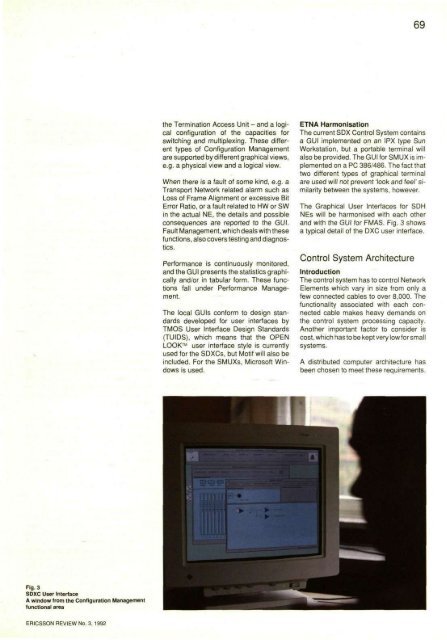An Introduction to the Ericsson Transport Network Architecture ...
An Introduction to the Ericsson Transport Network Architecture ...
An Introduction to the Ericsson Transport Network Architecture ...
Create successful ePaper yourself
Turn your PDF publications into a flip-book with our unique Google optimized e-Paper software.
69<br />
<strong>the</strong> Termination Access Unit - and a logical<br />
configuration of <strong>the</strong> capacities for<br />
switching and multiplexing. These different<br />
types of Configuration Management<br />
are supported by different graphical views,<br />
e.g. a physical view and a logical view.<br />
When <strong>the</strong>re is a fault of some kind, e.g. a<br />
<strong>Transport</strong> <strong>Network</strong> related alarm such as<br />
Loss of Frame Alignment or excessive Bit<br />
Error Ratio, or a fault related <strong>to</strong> HW or SW<br />
in <strong>the</strong> actual NE, <strong>the</strong> details and possible<br />
consequences are reported <strong>to</strong> <strong>the</strong> GUI.<br />
Fault Management, which deals with <strong>the</strong>se<br />
functions, also covers testing and diagnostics.<br />
Performance is continuously moni<strong>to</strong>red,<br />
and <strong>the</strong> GUI presents <strong>the</strong> statistics graphically<br />
and/or in tabular form. These functions<br />
fall under Performance Management.<br />
The local GUIs conform <strong>to</strong> design standards<br />
developed for user interfaces by<br />
TMOS User Interface Design Standards<br />
(TUIDS), which means that <strong>the</strong> OPEN<br />
LOOK user interface style is currently<br />
used for <strong>the</strong> SDXCs, but Motif will also be<br />
included. For <strong>the</strong> SMUXs, Microsoft Windows<br />
is used.<br />
ETNA Harmonisation<br />
The current SDX Control System contains<br />
a GUI implemented on an IPX type Sun<br />
Workstation, but a portable terminal will<br />
also be provided. The GUI for SMUX is implemented<br />
on a PC 386/486. The fact that<br />
two different types of graphical terminal<br />
are used will not prevent 'look and feel' similarity<br />
between <strong>the</strong> systems, however.<br />
The Graphical User Interfaces for SDH<br />
NEs will be harmonised with each o<strong>the</strong>r<br />
and with <strong>the</strong> GUI for FMAS. Fig. 3 shows<br />
a typical detail of <strong>the</strong> DXC user interface.<br />
Control System <strong>Architecture</strong><br />
<strong>Introduction</strong><br />
The control system has <strong>to</strong> control <strong>Network</strong><br />
Elements which vary in size from only a<br />
few connected cables <strong>to</strong> over 8,000. The<br />
functionality associated with each connected<br />
cable makes heavy demands on<br />
<strong>the</strong> control system processing capacity.<br />
<strong>An</strong>o<strong>the</strong>r important fac<strong>to</strong>r <strong>to</strong> consider is<br />
cost, which has <strong>to</strong> be kept very low for small<br />
systems.<br />
A distributed computer architecture has<br />
been chosen <strong>to</strong> meet <strong>the</strong>se requirements.<br />
Fig. 3<br />
SDXC User Interface<br />
A window from <strong>the</strong> Configuration Management<br />
functional area<br />
ERICSSON REVIEW No. 3, 1992
















